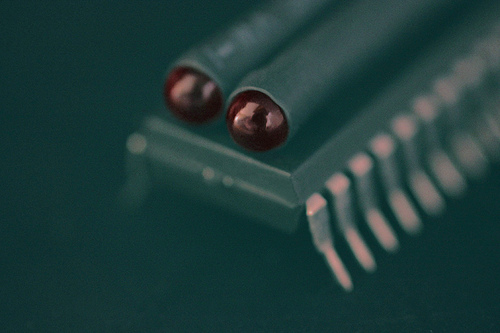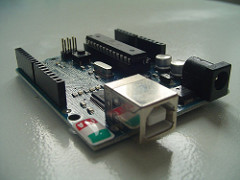
Photo by Vincil from Ummo
In August 2009, the Chinese Premier Wen Jiabao held a speech in Wuxi during which he presented the following equation
Internet + Internet of Things = Wisdom of the Earth
The term Internet of Things (IoT) describes technologies and disciplines enabling everyday objects to access the Internet, ask questions about our environment and, to quote Dana Cuff (UCLA Dept. of Urban Planning), generate data commons. The equation suggests we could better understand the impact we have on our environment and hopefully act to preserve it. The second IoT conference will take place coming November in Tokyo, Japan precisely around the theme “IoT for a Green Planet”. The first one was held in Zurich in 2008 at the initiative of the University of St. Gallen, ETH Zurich and MIT.
This post introduces IoT and open source sensing hardware as enabler for Citizen Sensing solutions.
From smart dust to motes
The idea of IoT and sensor networks goes back to the mid nineties with radio-based networks of sensors for Auto ID solutions. Auto-ID Sensor Networks provide RFID systems with the ability to manage data collected from a network’s edge. In 2005, Wal-Mart and the US DoD (who run the two largest supply chains on the Planet) made their first requests for RFID solutions for inventory control. In 2009, US DoD awards contract in DASH7 infrastructure. DASH7 is a wireless protocol alternative to ZigBee or Near Field Communication which is required for device communication. The Internet Protocol Smart Objects Alliance was launched in 2008 as a global non-profit organization to promote the use of the Internet Protocol as the preferred way to access and communicate with sensors. Wireless Networked Sensors (WSN) are made of nodes which can be divided into 4 classes: special-purpose sensor nodes, generic sensor nodes, high-bandwidth sensor nodes and gateway nodes. The Spec node is an example of special-purpose sensor node designed for ultra low-cost and low-power operation with a size expressed in cubic-millimeter scale. They are sometimes synonymous with Smart Dust (see The Invincible by Stanislaw Lem). At the next level (cubic-centimeter scale) there are Berkeley Motes as example of generic sensing device mainly used in research. The Crossbow Mica2/MicaZ are examples of commercial motes. When the requirements include live capture of audio or video, more powerful devices are needed such as the Intel iMote representative of the high-bandwidth sensor nodes. Gateway nodes can provide a Web-based UI to other nodes using various networking technologies. Arduino has joined the list as an open source platform alternative with its ecosystem of companies providing add-on boards to address generic sensing and gateway node requirements.
Sensor technology has been applied by universities on interesting environmental projects:
- UCLA Center for Embedded Network Censing Projects with Terrestrial Ecology Observing Systems, Microbial Observing Systems, Seismic
- Extensible Sensing System at UC James Reserve: continuous monitoring of the ambient microclimate above and below ground based on Tiny Diffusion – a hierarchy of miniature weather stations measuring sunlight, humidity, air pressure, and temperature packaged into a small plastic cone connected wirelessly to gateway nodes feeding the data to Oracle/LabVIEW/MatLab clients.
- Sensorpedia: program initiated by Oak Ridge National Laboratory to utilize Web 2.0 social networking principles to organize and provide access to online sensor network data and related data sets
Large industrial players have also bought into the opportunities brought by WSN with concrete applications for public and private organizations. These are defined around seemingly common visions of an intelligent habitat:
- Hewlett-Packard CeNSE
- HP embarked on a 10-year mission to embed a trillion pushpin-size sensors around the Globe forming a Central Nervous System for the Earth: interconnected inexpensive sensors measuring and processing all sorts of data in real time, to improve safety, sustainability, and security of people and businesses. Areas of focus include the tools of network information theory, allowing for new architectures, protocols, and codes that go well beyond those deployed in state-of-the art networks today.
- IBM Smarter Planet
- beginning of 2010, IBM Chairman Sam Palmisano addressed Chatham House in London, where he described how forward-thinking leaders in business, government and civil society around the world are capturing the potential of smarter systems to achieve economic growth, near-term efficiency, sustainable development and societal progress.
- Cisco Intelligent Urbanisation
- holistic blueprint for “Intelligent Urbanisation,” a global initiative to help cities around the world use the network as the next utility for integrated city management, better quality of life for citizens, and economic development.
- Sony NoiseTube
- research project, started in 2008 at the Sony Computer Science Lab in Paris, which aims to develop a new participative approach for monitoring noise pollution by involving the general public.
- Alcatel-Lucent Smart Santander
- city-scale experimental research facility in support of new applications including experimental advanced research on IoT technologies and realistic assessment of users’ acceptability tests. The facility will comprise more than 20,000 sensors.
- Intel Common Sense
- mobile environmental sensing platform to support grassroots community action. The Common Sense project develops a family of hardware and software components that can be used in a rang of applications such as San Francisco’s street sweeper trucks collecting street-by-street air quality or handheld monitors populated with commercial sensors (carbon monoxide, nitrogen oxides, ozone gas, light, temperature, relative humidity and orientation) and an associated web portal for data visualization.
- Google PowerMeter
- free energy monitoring tool that helps viewing home’s energy consumption online.
The beauty of the Internet as it stands today is that you don’t have to be a giant company to create something innovative. Internet offers a number of key infrastructure services and open source software which let people innovate in fascinating ways:
- Living City: a platform for the future when buildings talk to one another. Living City is an ecology of facades where individual buildings collect data, share it with others in their social network, and respond to the collective body of knowledge.
- blackcloud.org: this grassroots project materializes the Black Cloud of pollution by capturing 6 parameters - volcanic organic compounds, carbon dioxide, light, noise, temperature and relative humidity.
- Ushahidi: Brazilian elections 2010 or Ethiopia Vote Monitor are two civic engagement projects supported by the Kenyan platform whose name stands for testimony in Swahili. This platform even fell under the radar of Clay Shirky which remarked at TED how it had spread worldwide in less than three years to become the default tool for crisis-mapping.
Sensing hardware at the cost of a Pizza

Photo by pedro mg
The photo represents an Arduino board. Arduino is a venture which started in 2005 and was made popular in recent years through tinker.it and Make:. What is this? A mashup of individual hardware and software components forming a prototyping platform which does not require and Electrical Engineering degree. The Arduino is a combination of board and development environment without user interface in the traditional sense. The interface used by Arduino are a combination of analog and digital input pins which let creators use air quality sensors, GSM shield (they’re complete snap-on boards which can be stacked on top of the Arduino), GPS shield, or Ethernet shield for connected applications.
Here is a simple example of using an Arduino as a temperature sensor. The project shows how to assemble the components and provides source code for reading and plotting the sampled values.
It is ideal for environments which require only a few computing cycles to perform a task and where using a PC would be overkill. It’s been priced at the cost of a Pizza (around 20 to 22 Euros in Italy) by its inventors to make it more affordable than kits such as Lego Mindstorms or PicoCricket. The idea was to enable physical computing and allow people to explore the intersection between art and technology, e.g. Jean-Michel Jarre’s Laser Harp. But the low cost attracts a wide range of individuals and a quick search on environmental applications also yields interesting projects:
- Plants that tweet for more water: botanicalls
- A map collecting Arduino feeds from around the world: Pachube is a data brokerage platform for the internet of things, managing millions of datapoints per day from thousands of individuals, organisations & companies around the world. It enables storage, sharing & discovery of realtime sensor, energy and environment data from objects, devices & buildings around the world. This post explains how to assemble and connect an Arduino microcontroller to Pachube.
- OpenEnergyMonitor: a project to develop and build open source energy monitoring, control and analysis tools for energy efficiency and distributed renewable microgeneration.
While an Arduino board alone should not be compared with traditional WSN motes, it can be enhanced via optional shields to become one. A Mica2 board costs approximately USD 150. An Arduino-based mote such as Libelium’s Squidbee comes at EUR 150. Libelium is the manufacturer of other interesting products such as the Placa Agricultura – see this link for more details.
Issues and concerns
IoT for citizen sensing is still in its infancy and brings with it a number of challenges such as:
- Ownership
- Copyright law protects creative expression but not the underyling data. In fact, citizen sensing might be less based on financial incentives than attribution which is common in open source software communities. The incentive would revolve around the ability to see what their data contributes to the whole. In this case, strict intellectual property rights over data commons could instead lead to a tragedy of anti-commons with coordination costs making the use of information impossible.
- Privacy
- Citizen sensing is a matter of self-surveillance – we’ll be wearing the sensors or have them in our car or home. It should be possible to anonymize the data collected and support authentication mechanisms to assert the legitimacy of a source.
- Observer effect
- DIY devices collecting data yields junk data or produce a mediocre analysis of the data due to lack of training in statistics. Dana Cuff recognized this concern but also suggested some ways to compensate adverse effects. In fact she dares to push it even farther saying that _the idea of urban sensing should go beyond science, unabashedly, into the realm of art and politics where data quality may not be what is most important. Ushahidi for instance implements two statuses for a report: approved (for publication) and verified. A report can be published but remain unverified.
- Liability
- Applications supporting citizen sensing applications will collect lots of data. To what extent would such an organization be liable for the data it gathers? While this has been addressed in the context of third-party copyright liability, copyright doesn’t attach to data. Jerry Kang (UCLA) suggests that instead such database intermediaries might be held liable under tort law such as defamation but existing regulations could exonerate intermediaries – legal protections designed for very different contexts may have surprising or unexpected consequences on the building of data commons.
- Participants
- Common Sense identified a number of constituents on its steet sweeper project – government, emitters, and public interest advocates. These actors have different agendas and raise interesting questions relative to change advocacy, e.g. how to use the analysis derived from the data, how much data is needed before reaching the tipping point and focusing on mobilizing people.
- Health
- Pacific Gas & Electricity in California has deployed over 5 million SmartMeters which allow citizens to measure their electricity and natural gas usage. PG&E dealt recently with complaints questioning their accuracy (see observer effect which doesn’t seem restricted to DIY sensors) and possible effects on human health. The use a various radio transmission technologies will require a transparent communication explaining to people what is actually being used and why.
- Purpose
- Is the data politically relevant? What will it be used for? Should citizens focus on the solution instead? More data can in some cases be undesirable and it seems essential (as asking Why? always is) that citizen sensing and building data commons be relevant to action.
- Legitimacy
- What regulations, norms or standards should be followed when collecting data? Have the models used to crunch the data been communicated and was a consensus reached on their acceptance?
- Usability
- How complex is the deployment of sensors? Do citizens have to build the sensors or can they be bought and easily installed? What about maintenance and handling? In some cases, sample data needs to be downloaded periodically say via USB to a computer. Can such a model scale across a larger population? The user interface to data commons visualizations should furthermore help participants determine whether action is necessary or not.
- Technology aversion
- Some communities which are very sensitive to the environmental agenda might not welcome the idea to install electronic sensors in a home that’s been carefully preserved from pointless objects so common in our consumerist societies.
Citizen sensing needs design models
Our society is shifting towards real-time sensing, e.g. from yearly visits to the doctor to a continuous feed of vital metrics sent by a gizmo inside your belt which will prompt the doc to call you. And yes, Internet of Things will become a key enabler to make this shift. But the expansion of Internet to everyday objects asking questions about our environment will raise many new questions and challenges but also new ways to go about change in society. Open source software has brought a healthy dose of innovation to the Internet and will do the same with open source hardware to the Internet of Things which was until reserved to large-scale research. This push in innovation will accelerate the movement.
But as some examples show, it’s not just about technology. Organizational aspects play an important role in the successful deployment and anticipated change derived from the use of citizen sensing solutions. Management cybernetics can contribute with systematic variety engineering needed to manage organization state at various levels of the hierarchy from sensing devices at the very bottom and strategic environmental imperatives at the very top (whatever the top is – city, region, nation). In other words, participatory design includes mechanisms e.g. to filter large amounts of data and preserve interesting outliers or to identify which outlier data deserves to be discussed by what group of constituents in the social hierarchy based on which trigger.
Establishing sound design principles of organization in citizen sensing projects will become a priority as innovation in IoT will accelerate and bring concrete solutions to society’s environmental issues.
 This material is licensed under CC BY 4.0
This material is licensed under CC BY 4.0
